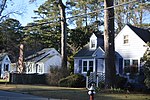Naval Air Station Oceana

Naval Air Station Oceana or NAS Oceana (IATA: NTU, ICAO: KNTU, FAA LID: NTU) is a United States Navy Naval Air Station located in Virginia Beach, Virginia. The base is under the jurisdiction of Navy Region Mid-Atlantic and is the headquarters of Strike Fighter Wing Atlantic and Carrier Air Wings 1, 3, 7 and 8. As home to all east coast strike fighter jet squadrons, the Naval Air Station is classified as a master jet base. The airfield is known as Apollo Soucek Field, named after Lieutenant (later Admiral) Apollo Soucek, a Navy test pilot who set the global altitude record in 1930 by flying a Curtiss "Hawk" biplane to an altitude of 43,166 feet. Constructed in 1941, and officially commissioned in 1943, NAS Oceana has been home to carrier-based aircraft since its inception. The field serves as home for 14 deployable Strike Fighter squadrons operating the F/A-18E/F Super Hornet, a Strike Fighter Fleet Replacement Squadron, an adversary squadron, and a logistics squadron. Additionally, NAS Oceana operates Dam Neck Annex, a separate military installation that is home to other non-flying commands, including various school houses, and Naval Auxiliary Landing Field Fentress, a practice carrier landing field, in nearby Chesapeake, VA. The air station is not open to the public except one weekend each year, usually in September, when it hosts the NAS Oceana Air Show.
Excerpt from the Wikipedia article Naval Air Station Oceana (License: CC BY-SA 3.0, Authors, Images).Naval Air Station Oceana
The Throat, Virginia Beach
Geographical coordinates (GPS) Address Nearby Places Show on map
Geographical coordinates (GPS)
| Latitude | Longitude |
|---|---|
| N 36.820555555556 ° | E -76.033333333333 ° |
Address
The Throat
23454 Virginia Beach
Virginia, United States
Open on Google Maps






